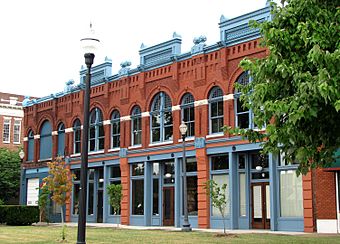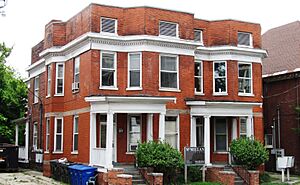Emory Place Historic District facts for kids
Quick facts for kids |
|
|
Emory Place Historic District
|
|

6-12 Emory Place
|
|
| Location | Roughly bounded by Broadway, N. Central, Emory, Fifth, East Fourth, and King Knoxville, Tennessee |
|---|---|
| Area | approximately 10 acres (4.0 ha) |
| Built | 1880–1930 |
| Architect | Charles I. Barber, Albert Baumann, Sr., Dean Parmalee, R. F. Graf, etc. |
| Architectural style | Romanesque Revival, Neoclassical Revival |
| NRHP reference No. | 94001259 |
| Added to NRHP | November 10, 1994 |
The Emory Place Historic District is a special area in Knoxville, Tennessee, just north of the city center. It's full of old shops, homes, churches, and public buildings. These buildings grew up around a train and trolley station from the late 1800s.
Some important buildings in the district include the Knoxville High School building, St. John's Lutheran Church, and First Christian Church. You can also find some of the few remaining rowhouses in Knoxville here. This area was added to the National Register of Historic Places in 1994, which means it's important to protect.
After railroads were built in the 1850s, Knoxville slowly grew north. In 1890, a train line called the "Dummy Line" connected Knoxville to Fountain City. Emory Place was the end of this line. A farmers' market and many small businesses started here because of all the new customers and easy transportation. Even though Emory Place became less busy when Knoxville's trolley system closed in the late 1940s, many of its old buildings from the late 1800s and early 1900s are still standing and have been fixed up.
Contents
Where is Emory Place Located?
The Emory Place Historic District is shaped like a triangle. It's where Broadway and Central Street meet, and also where Broadway and Fifth Avenue meet. Interstate 40 and the Southern Railway tracks separate the district from downtown Knoxville to the south. The Fourth and Gill neighborhood is to the north, and Old Gray Cemetery is across Broadway to the west.
Emory Place itself is a street that connects Central and Broadway. It used to be a very wide road, but now much of it is used for parking. Gay Street, which is downtown Knoxville's main road, goes through the Emory Place Historic District and ends at Emory Place.
A Look Back: History of Emory Place
Early Days and the Civil War
In the early 1800s, what is now Emory Place was mostly farmland. Two big things happened in the 1850s that helped the area grow. First, Old Gray Cemetery was started in 1850. It was like a public park and brought people to the area. Second, the railroad reached Knoxville in 1855, pushing the city's northern edge closer to Emory Place. The Emory Place area officially became part of Knoxville in 1855.
During the American Civil War on July 20, 1863, Union General William P. Sanders placed cannons along what is now Fifth Avenue. He tried to attack Knoxville, which was held by Confederate forces. But the Confederate soldiers fought back, and Sanders had to leave. During the Siege of Knoxville in late 1863, Confederate lines were also in this same area.
After the war, Knoxville kept growing north. By 1867, the Knoxville Foundry was built near Broadway and Depot. Farmers from outside the city started selling their produce from wagons along Emory Place. People visiting Old Gray Cemetery would buy from them. By the late 1880s, Emory Place was known as "Central Market."
The "Dummy Line" Arrives
In 1890, the Fountain City Railroad, often called the "Dummy Line," was built. It connected Knoxville to the Fountain Head resort in Fountain City. A train station was built at Broadway and Emory Place, which was the end of the line. The area around the station quickly started to grow. A large market house with 33 stalls was built for the Central Market farmers around the time the railroad was finished. Small factories also opened near the station, like the Whittle and Spence Trunk Company (1890), the Knoxville Candy Company (1891), and the Walla Walla Gum Company (1896).
Many of the new business owners and people living in Emory Place were the children and grandchildren of Irish and German immigrants. These families had come to Knoxville in earlier years to help build the railroads. The city's second Catholic church, Holy Ghost, was built along North Central. St. John's Lutheran Church was built by German families who were born in America. At one time, the businesses in Emory Place were run by people from many different backgrounds.
"Emory Place" is named after Reverend Isaac Emory (1830–1904). He was a minister from New York who moved to a farm north of Knoxville after the Civil War. He spent many years setting up Sunday schools across the state. In 1904, Emory died in a train accident. A park next to the Central Markethouse was renamed "Emory Park" in his honor. This park was Knoxville's only city park until it was removed in the 1950s and replaced with parking lots.
The Twentieth Century Changes
In 1905, the Dummy Line was replaced by an electric trolley. Emory Place slowly became more of a neighborhood with homes as many small businesses closed or moved away. Several rowhouses and apartment buildings were built along Central and Fifth, like the Sterchi (now Sterchi Oaks) and the Lucerne. Knoxville High School was built in 1910. Its spot at Fifth and Central was chosen partly because it was close to the trolley station at Emory Place.
When the trolley system was taken down in 1947 and the Magnolia Expressway (now part of I-40) was built in 1951, Emory Place started to decline. Car dealerships were the main businesses in Emory Place until the 1970s.
Since the 1980s, many buildings in Emory Place have been fixed up. Some of the old rowhouses and hotels have been turned into modern apartments called condominiums. In 2010, a group called Emory Place Partners bought several properties. They planned to fix them up and use them for offices and shops.
Important Buildings in the District
The Emory Place Historic District has 23 important buildings and one special statue. Most of these buildings were built in the early 1900s. The two oldest, 6-12 Emory Place and 15-17 Emory Place, were finished in 1890. You can see different building styles here, like Colonial Revival, Neoclassical, and Richardsonian Romanesque. St. John's Lutheran Church, at Emory Place and Broadway, was listed on the National Register by itself in 1985.
Knoxville High School Building
The Knoxville High School building is a two-story building with Neoclassical and Beaux-Arts styles. It was finished in 1910. A famous Knoxville architect named Albert Baumann, Sr., designed it. Knoxville High School was in this building from 1910 until 1951. After that, it was split into four smaller high schools. The "Doughboy Statue" on the school's front lawn was put up in 1921 to remember Knoxville's World War I soldiers.
First Christian Church
The First Christian Church (211 W. Fifth Ave.) was built in 1913. It was designed by another well-known Knoxville architect, Charles I. Barber. Barber also designed the church's office building and Sunday school building, which were both finished in 1929. This church is home to a Disciples of Christ group.
The church is a two-story building with Neoclassical style and some Romanesque touches. Its outside walls are made of brick, with marble details. The front has six marble columns that support a triangular roof section.
The church's Sunday school building is a two-story Romanesque building with a Spanish tile roof. The church, Sunday school, and office building are all connected by arched walkways and surround a central courtyard.
3 Emory Place
The building at 3 Emory Place used to be three separate units. It was built by the Walla Walla Gum Manufacturing Company, which made chewing gum in the early 1900s. The building was fixed up in 2010 by an architectural firm. Now, an office design company uses it.
6-12 Emory Place
6-12 Emory Place is sometimes called the W. F. Green and Company Grocery Store building. It's a two-story brick building in the Richardsonian Romanesque style, built in 1890. It has arched windows on the second floor with stone bases.
15-17 Emory Place
15-17 Emory Place is known as the Whittle and Spence Trunk Company building. It's a two-story building also in the Richardsonian Romanesque style, built in 1890. It has an unusual shape, with one part of the building facing south and another part facing southeast. An accounting firm uses the building now.
The Lucerne Apartments
The Lucerne (201 West Fifth Avenue) is a three-story brick apartment building. It was built around 1925 by James G. Sterchi, who owned a furniture store. The building has a front porch with stone columns. In its early years, a popular tea room for women was in the basement of the Lucerne. Today, it's a condominium building.
Sterchi Oaks Apartments
Sterchi Oaks (205 West Fifth Avenue) is another three-story brick apartment building. It was also built around 1910 by James G. Sterchi. This building has porches and balconies on all three levels. The first-floor porch has brick arches. The second and third-floor balconies have columns and brick railings. This building is also a condominium now.
Patterson Cottage
Patterson Cottage (605 King Street), also called "L'Hotel," is a two-story brick apartment building in the Neoclassical style. It was built around 1910. It has a stone trim around the top of the building. This building is also a condominium today.
507-509 N. Central Street
507-509 N. Central Street, now called McMillan Place, is a two-story, two-unit rowhouse. It's in the Colonial Revival style and was built around 1905. The building has a brick outside and flat roof. The front porches have wooden columns and railings.
Images for kids









